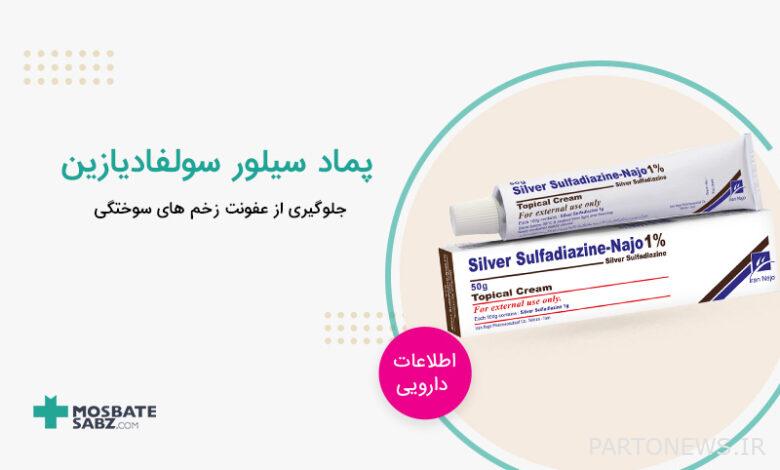What is silver sulfadiazine ointment?

Silver sulfadiazine ointment is a topical antibiotic used to prevent and treat burn wound infections. This ointment contains silver sulfadiazine, which is an antibiotic from the sulfamide group and works by inhibiting the synthesis of folic acid, which is an essential nutrient for bacterial growth. Before using silver sulfadiazine ointment, wash your hands well and clean and dry the affected skin area. Then, apply a thin layer of ointment on the affected area and massage gently. In addition to antimicrobial effects, silver sulfadiazine ointment also has anti-inflammatory and analgesic effects.
What we read in this article
Pharmaceutical forms of silver sulfadiazine
Chemical and herbal medicines produced by pharmacies are produced in various medicinal forms, such as tablets, syrups, capsules, injectable solutions, serums, etc. The doctor should prescribe different types of drugs according to the physical conditions, medical records and age of the patient (adults, children and elderly). Silver sulfadiazine is available in the market as a 1% topical cream or ointment.
Uses of silver sulfadiazine ointment
This medicine is used along with other treatments to help prevent and treat wound infections in patients with serious burns. Silver sulfadiazine works by stopping the growth of bacteria that may infect an open wound. This process helps reduce the risk of bacteria spreading to the skin or blood that can cause a serious blood infection (sepsis). The use of this ointment in children and the elderly should be done with a doctor’s prescription, because it will cause serious side effects. The most important uses of this drug are in burn wound infection in adults and children.
Pharmacological effects and mechanism of action of silver sulfadiazine drug
The mechanism of action of silver sulfadiazine ointment acts on the cell membrane and cell wall. This drug has a bactericidal effect on many Gram-negative and Gram-positive organisms, in addition, it is also active against yeasts and Candida albicans. The peak plasma time of this product is 3 to 11 days and it is excreted through urine (50%).
The dosage of silver sulfadiazine
Before starting to use silver sulfadiazine, read the drug information on the product packaging. The amount and time of general use of this ointment is written on it. This medicine is for skin use only. Do not use this product around the eyes without a doctor’s prescription. Apply the ointment to the wound using sterile techniques (such as a sterile dressing). Apply this ointment on the desired area once or twice a day according to the doctor’s instructions, if necessary, you can use gloves and sterile tools.
How to use sulfadiazine ointment
- For the treatment of burn wound infection, apply 1/16 inch or 2 mg to the affected area every 12 hours.
- To treat burn wound infection in children, use every 12 hours in children older than 2 months. It should be noted that the use of this ointment is contraindicated in children under 2 months.
- If you run out of ointment and need to reapply it, repurchase the product as burns should always be covered with cream.
- Continue use until the burn is healed or ready for grafting. If infection is suspected, continue treatment unless significant adverse reaction occurs.
- It should be used with caution in people with special medical records such as skin allergies, kidney and lung problems.
Time to use silver sulfadiazine ointment
Treatment with silver sulfadiazine ointment usually continues until the wound is completely healed or until the site is ready for skin grafting. Use this medicine regularly to get the most benefit from it. Use it at the same times every day to help you remember. If your condition continues or worsens after using this ointment, stop using the ointment and consult a doctor. Do not use any medicine for burns without a doctor’s prescription, because burns are a sensitive medical condition and self-medication can be dangerous.
Precautions
Patients Before using silver sulfadiazine ointment, tell your doctor or pharmacist if you are allergic to it or similar drugs. This product may contain inactive ingredients that can cause allergic reactions or other problems. Before use, medical records such as specific enzyme deficiency (G6PD or glucose-6-phosphate dehydrogenase deficiency), kidney problems, liver problems, leukocytosis. Inform the doctor about the number of cells, etc. The doctor will prescribe the best prescription for you according to your physical conditions and medical records to reduce the risk of side effects.
- In case of G6PD deficiency, use with caution and as directed by the doctor.
- This ointment is only for topical use on the skin, it is forbidden to use it on the eyes or inside the body.
- Prolonged use may lead to bacterial or fungal superinfection.
- Use in pregnant women is not recommended unless the burned area covers more than 20% of the body surface or the therapeutic benefits for the patient outweigh the potential risks to the fetus.
- Although silver sulfadiazine is minimally absorbed, it reacts with body fluids to release sulfadiazine, which may reach significant serum concentrations.
- The absorption of silver sulfadiazine varies depending on the percentage of body surface area and the extent of tissue damage. Any adverse reaction associated with sulfonamides may occur, including blood dyscrasias, skin and allergic reactions (including life-threatening skin reactions such as Stevens-Johnson syndrome (SJS). ), toxic epidermal necrolysis (TEN), exfoliative dermatitis) and gastrointestinal reactions.
- Long-term use of this ointment on the skin causes skin allergies and itching.
Contraindications to Psilor Sulfadiazine
Contraindications and precautions are mentioned on the packaging of pharmaceutical products. Silver sulfadiazine ointment, like other products, has contraindications that must be followed. For this reason, patients should use this ointment according to the doctor’s prescription to see the least side effects along with the maximum benefit. Avoid long-term use without a doctor’s prescription, because long-term use of any drug will cause dangerous side effects.
- Pregnant women close to giving birth
- Sulfa allergy
- Hypersensitivity
Side effects of silver sulfadiazine
Pain, burning, pimples, skin color change, etc. are some of the side effects of silver sulfadiazine ointment. After using this ointment, the skin or mucous membranes (such as gums) may turn blue or gray. If any of these effects persist or worsen, tell your doctor or pharmacist right away. Most people who use this drug do not experience serious side effects. Patients should avoid excessive and non-prescription use of this ointment to avoid side effects or drug interactions.
If you have serious side effects, such as signs of infection (such as a sore throat that does not go away, fever, chills), bruising or bleeding, signs of anemia (such as unusual tiredness or weakness, fast breathing, fast heart rate), signs of kidney problems (such as changes in in the amount of urine, pink or bloody urine), symptoms of liver problems (such as nausea, stomach or abdominal pain, vomiting, dark urine, yellowing of the eyes or skin), mental or mood changes, etc., stop taking the medicine and see a doctor . By observing and checking these side effects, the doctor will change your medication or dosage.
- Pain, burning, itching and hives
- skin necrosis
- Erythema multiforme
- Transient skin discoloration
- Hemolytic anemia (in patients with G6PD deficiency)
- Agranulocytosis
- Thrombocytopenia
- Aplastic anemia
- Skin reactions and hypersensitivity
- Leukopenia

Drug interaction of silver sulfadiazine
Drug interactions may change how your medications work or increase your risk of serious side effects. Patients, before going to the doctor, prepare a list of different medicines you use (either herbal or chemical) and show them to him. Do not start, stop, or change any medication without your doctor’s approval. Skin medicines containing sulphastamide sodium, enzyme products used to break down and destroy skin or dead tissue from burns and wounds cause drug interactions with silver sulfadiazine ointment. Note that this product is only for topical use on external parts (skin) of the body.
Use of silver sulfadiazine during pregnancy and breastfeeding
Many studies and information regarding the effects of silver sulfadiazine ointment on pregnant women and fetuses are not available. Animal studies have not shown any danger and there are no specific human studies in this field. Therefore, pregnant women and lactating mothers should use this product with a doctor’s prescription and advice so that we do not see side effects or drug interactions. It should be noted that it is not yet clear whether silver sulfadiazine has an effect on breast milk or the fetus, so avoid taking it without a prescription.
Storage conditions for silver sulfadiazine ointment
Silver sulfadiazine should be stored at room temperature (preferably cool) away from light and moisture. Keep all chemical and herbal medicines out of the reach of children and animals. Dispose of this product properly when it has expired or is no longer needed. Avoid pouring all kinds of medicines into the toilet well, street and sewer.
The last word about silver sulfadiazine ointment
In the world of medicine and health, the development of innovative drugs and treatments are among the most important scientific and medical advances. One of the drugs that has attracted the attention of many researchers and doctors in this field and has found a special place in the treatment of skin and tissue infections is silver sulfadiazine ointment.
By reading this article from the online positive green pharmacy magazine, you will get to know the key role of silver sulfadiazine ointment in maintaining skin health and dealing with skin infections. With its high effectiveness in dealing with resistant bacteria, relying on antibiotics and its benefits, this drug can be effective in improving skin health.
Site source: medscape

